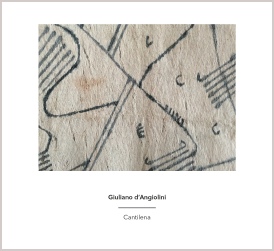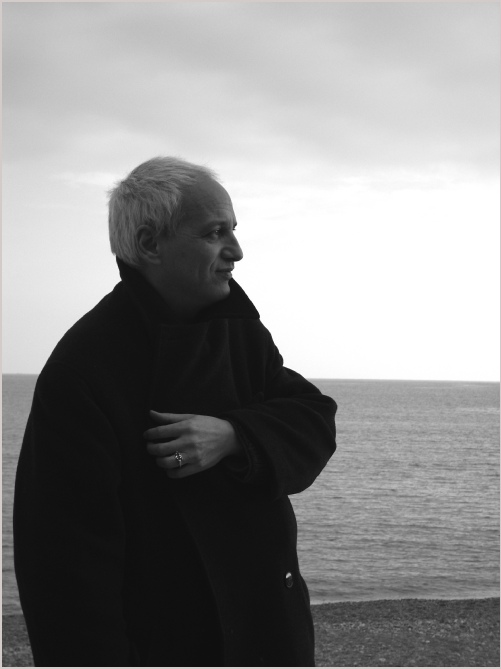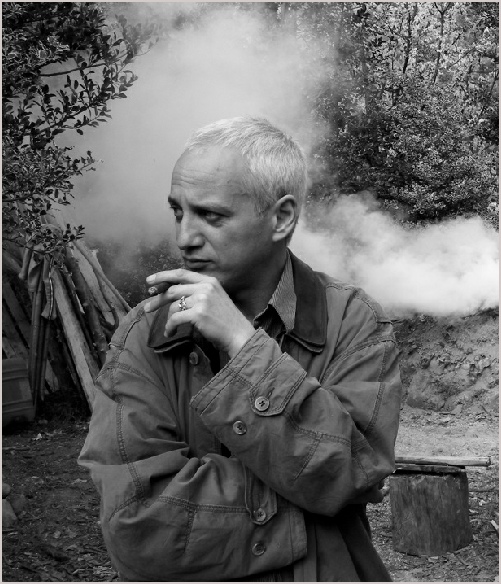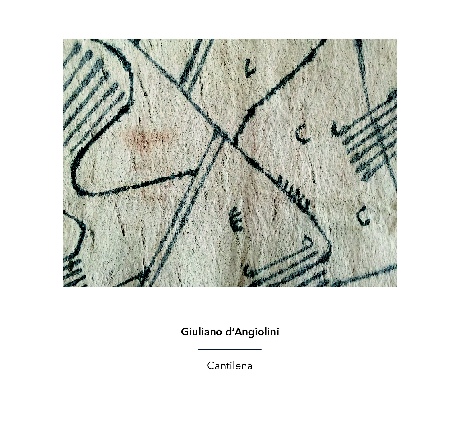Another Timbre TimHarrisonbre

at102 Giuliano d’Angiolini - ‘Cantilena’
Six chamber works by the Paris-based Italian composer.
1 Aria del flauto eolico (2015) Manuel Zurria (flutes) 7:16 Youtube extract
2 Finale (2012) Melaine Dalibert (piano) 18:27 Youtube extract
3 Cantilena (2014) Quatuor Parisii 5:20
Quatuor Parisii: Arnaud Vallin & Doriane Gable (violins), Dominique Lobet (viola), Jean-Philippe Martignoni (cello)
4 Allegretto 94.6 (2002) Melaine Dalibert (piano) 5:56
5 (suoni della neve e del gelo) (2014) Quatuor Parisii 10:03
6 Motivetto (2009) Ensemble Chrysalide 5:59
Baptiste Boiron (saxophone), Benjamin Boiron (cello), Melaine Dalibert (piano)
Interview with Giuliano d’Angiolini
On the cover of the CD you say that four of the works - Aria del flauto eolico, Cantilena, (suoni della neve e del gelo), Motivetto – were composed using indeterminate procedures. Could you say a bit more about how those compositions work and why you use indeterminacy in many of your pieces?
I began using indeterminate procedures in 1997, with Ita vita zita rita, and since then most of my compositions are indeterminate in one or more aspects. The problem is that each time you have to invent a procedure which is both efficient and which doesn’t become too complicated in its realisation. One excellent and remarkably elegant solution was produced by the genius of John Cage : time-brackets, which I have used several times starting Notturno in progressione and most recently Aria del flauto eolico and (suoni della neve e del gelo). With time brackets you can create a solid structure which is at the same time elastic as regards the placement of events in time. In Motivetto there are just two gamuts and some rules of behaviour which distinguish between short sounds, long sounds and their dynamics. In Cantilena, the interpreter chooses one note from a pentatonic anhemitonic scale. However with every attack it slides by one step in the chromatic field, as if you are hearing a sort of melody with simple intervals, with intervals and notes which appear to recur, but in fact are constantly being renewed. Durations occur naturally according to the type of instrumental gesture being used. Cantilena is a compositional machine which can produce a large number of different musics, but which belong to the same family.
Indeterminacy is a central question for me, and I regret that today it has been to some extent pushed to the margins, ignored or misunderstood. Too often art is artificial, and too often the artist tries to surprise us or force an emotion upon us. Indeterminacy or chance put a brake on our will. I like the idea that expression and emotion can rise up freely and spontaneously, and that they don’t have to be willed by the artist at a particular moment according to the logic of his or her taste or personal thoughts. Humans should be more discreet. The beauty which strikes me most (and which strikes all of us) is that of a landscape or of nature, and that is what I am trying to reconstruct.
You say that you particularly like the tradition of indeterminacy that has come down from Cage. When you started composing, were you already working in experimental music, or were you originally working in a different tradition?
My first compositions were consonant, which was pretty original at that time... My first piece worthy of the name used the structures and spirit of pygmy polyphonic music, which I’d recently got to know through the studies published by Sihma Arom (whereas I didn’t know Steve Reich’s music). Then I partially adopted serialism, which was current at that time in Italy and elsewhere, especially the way in which it was used by Stravinsky in his late compositions, which I studied a lot. I only truly came to understand John Cage’s approach later, having been interested in Buddhism. Some of his works inspired me directly, but I don’t feel part of an ‘experimental music’ tradition. However, I do have a great admiration for the work of Feldman, and in particular David Tudor, a great composer who is unjustly forgotten today.
I took a long time to find myself, or rather to refind myself, as it was a long and laborious journey to re-discover that which I had been spontaneously at the outset. So it’s like a Socratic, or perhaps a Buddhist, path as applied to music: to re-find yourself authentically.
Ah, so that’s why you wanted to use a picture of a pygmy barkcloth on the CD cover! You are also an ethnomusicologist. Does your work in this field continue to affect the music that you write?
I thought the picture was beautiful, and that it bore some relation to the music I write. In addition this barkcloth is in my living room, so I only had to take a photograph…
Apart from a few cases where I have borrowed directly from certain traditional oral musics, my work as an ethnomusicologist has perhaps influenced me in a broad sense, leading me sometimes to adopt certain choices, or indeed particular sonorities, but without being really fundamental.
You’re probably best known for your beautiful album on the Edition RZ label, Simmetrie di Ritorno. Most of the pieces on Cantilena were written considerably later than most of the works on that disc. Do you feel that your music has changed significantly over that period, or are both discs examples of a mature style that has settled?
I think that the compositions on both discs belong to my mature style, or perhaps they anticipate it, even if today I wouldn’t compose in the same way, nor use the same techniques as in the older pieces. But they are all works which I consider worth hearing. In fact I have rejected two thirds of my compositions, which has considerably rejuvenated my catalogue, and has made me a less prolific composer…
The world is currently enveloped in a gigantic background noise, and I don’t think it’s wise to add too many sounds to this noise. So I try to orientate myself towards only what is essential and do the least possible. I’ve chosen to develop my work not by shouting more loudly but by becoming more discreet. That is also my nature, although I’m not as wise as Tudor, who disappeared without leaving a trace, like a light breeze on a summer afternoon.
Do you think that your response to the noisy saturation of the world is utopian? Are you trying to withdraw from or ignore this deluge of sounds, and is that possible?
Perhaps it is utopian, but I don’t have any other means or strategies available. We are working in the shadows, like the monks of the middle ages.



Text by Giuliano d’Angiolini
Day after day
I have been told that my music is «radical», as if by including it in this category, one justifies its existence, as if one wanted to classify it so as to better delimit and domesticate its propositions. These indulgent observations (not to speak of open aversions) are elaborated in the musical milieu; the ears of the normal listener seem considerably more open. Music is the domain of musicians and musicians, but because of their training, are the least likely to understand it.
To be radical signifies, etymologically, to go the root of the problem and to stick to the questions and to the facts that flow there, without adding anything. So yes, I think that the composer should ask himself each time: «why this sound?» and well before: «why sound?».
The affair is delicate because there is already the beauty of the world. If we add our work, it is indispensable that it is not in conflict with that of nature, that the gesture not be destructive, that it not constitute an unnecessary perturbation. Ecology.
Each step of the creative path includes a certain quantity of approximation.
The virtuoso who shows the muscles of his trade practices a suspect activity: he tries to obtain approval, he seeks to create an illusion, to provoke admiration. Thus, art reduces itself to a fact of society, a means to recognize itself.
However, in order that it can awaken in us a consciousness and a «sensing», the artistic gesture must possess in itself an essential truth. It will be offered with sobriety and discretion; it will be sustained by the singular force of its evidentness. To banish virtuosity, to strip away skill, to throw away that knowledge that, by the way, one has obtained laboriously, in working.
Rigor, transpararency, against skillfulness, virtuosity. To become dilettantes. The man that becomes the Buddha that is in him, the Awakened one, is a common man. He has accomplished the totality of the pathway that brings him to being - authentically - an ordinary man.
(In the zen garden, the passage of the rake is a trace that underlines, like light makeup, and that succeeds abruptly in imposing a new order of appearance. It is a simple gesture, but full of force and efficacity. That which is transformed makes no resistance to change, because no violence is done to things: for the gravel already contains in itself the nature of the wave).
Deleuze: In art, in painting as in music, it is not a question of reproducing or inventing forms, but of capturing forces.
The composer must distance himself, make absent, and suppress in himself all aim. He will establish the criteria that will permit a process that allows the music to create itself all by itself.
Art (past and present) is too often artificial: the artist seeks to constrain the material, imprinting on it a direction in giving it a goal; he seeks to impose on us an emotion.
(Nevertheless composers are aware, sooner or later, that their music, at the moment when it is played and when one listens, goes well beyond that which they thought and wrote. The sound, the perceived sound, operates like a centrifugal force with regard to its articulation and to the formal construction. For sounds - whether isolated or in interaction between them - have their own life. They are crossed by lines of force which escape the control of the composer. All that invites humility).
«The right art», cried the Master, « s purposeless, aimless!»
[E. Herrigel, Zen in the Art of Archery].
One asks me if a music that refuses all expressive effect is therefore lacking in emotion for the listener. The sea, the mountain, the landscape, don't they produce in us an emotion, do they not have a poetry that is all their own? In an art that is without goal, the same as for a creation of nature, emotion will surge up spontaneously and will be free for he who looks or who listens.
The only art that is needed is an «artless» art.
I like consonant harmonies. They are simple and strong: this is a beautiful discovery of western music. I like consonance and also dissonance if it does not derive from an excess of organization, of will. Thus that of David Tudor, which is free.
The composition is the technique that consists of tracing a path permitting to discover new itineraries little by little while advancing.
Of time one can grasp nothing. That which we so name is a projection, an abstraction without consistency, of our experience of life. With modern physics, time has lost its absolute character and its constancy. Clocks don't beat the same hour everywhere in the universe.
I have the feeling, the intuitive conviction, that time is not foreign to bodies, a dimension on which they rely, but that time would be - a bit like gravity - an attribute, a property of bodies themselves, a dimension of bodies and of the individual that does not exist in itself. Time is the life that flows in the present.
The object of my compositions is the lyricism of this indefinite and immanent present which comes to be beyond - and even against - the illusory flow of metaphysical time, of a historical or psychological time made of climaxes and fractures.
Giacometti: And so there has been a transformation of the vision of everything... [...]. A person who spoke, this was no longer a movement, it was immobilities that followed each other, completely detached from each other, immobile moments that could last, after all, eternities, interrupted and followed by another immobility.
This night I dreamt of my death. I didn't really «dream» as one usually means; I didn't stage it and observe it from the exterior, as it happened for me to do so many times, but I lived it. The moment of death, such as I experienced it, carried the body in a backward motion and that awakened me. From this intense experience, I derive a teaching which is that of a truth directly experienced: one has the habit to think of death as something foreign to us, something that comes from the exterior and which frightens us. On the contrary, I felt that night that it was a manifestation of our intimate being, that comes from inside: we engender it like we do all phenomena that the mind or the body create all our lives. Death is, in this sense, natural; it is part - as is time- of our most intimate experience, and I would almost say, of our will.
Love is an act of faith. Creation also.
And so our cultural history trains us to listen to the relations between sounds, more than the sounds themselves. It pushes us to interpret these relations, to circumscribe a concept, to isolate a gesture of the will of the author, to locate a message, to discover a code which allows an act of communication. But there are no acts of communication in the music that I write. It has no intention to « signify ». I prefer to look at things as they are really; and those even when they are made heavy by a thickness that is given to them by the history of our culture, the history of our meanings. That having been said, I don't have the intention to deny the reflexes and effects that music provokes in us in all the various mental or physiological states of our perception.
Of course, things appear to each of us in a different manner. However, if between things and us there is no interpretative filter, no prejuidice, no discrimination or convention, we may establish with them a spontaneous, sincere and authentic relation. And so things appear in their singularity, as well as in the act of creation as in the act of perception. Now, they are as each of us can freely conceive them. There remains, therefore, of things - sounds, for example - only superficial appearence, the surface.
John Cage : There must be nothing between the things which you have separated so they wouldn't obstruct each other. Well, that nothing is what permits all things to exist.
Music is everywhere. It satisfies functional necessities. It can serve as a basis for dance, it can liberate energies or, inversely, create an order that reassures, an aura that assuages. It can be a scenery, a background, be destined to create an atmosphere, or to cover the holes in conversations. Music fills spaces in restaurants and cafés, stores and supermarkets, airports, even sometimes streets. One doesn't listen. One should not believe, by the way, that things pass any differently in the concert hall: the public is actually incapable of sharing the « language » of classical music, that which demands on the part of its listeners a knowledge of its vocabulary, its grammar and its syntax.
I draw my conclusions from this transformation of the modalities of listening and I take advantage of this. The music that I write can be listened to with concentration or with a happy indifference. It has, perhaps, the merit of not imposing itself on the listener. Its a music that presents to our attention particular events, but which have no evolution and which offer nothing on the level of form. It can, possibly, be played in the background, as a kind of musique d'ameublement («furniture music»), without anything being lost. One is free to listen or not listen.
Nothing impedes the listener to distance himself from the music: from the moment where there is neither narration, nor evolution, one loses nothing. The absence of a narrative or of dramatic articulation denies a listening centered on meaning so as to concentrate on the sonic event in itself. And because there is no hierarchy between events, to detach from certain amongst those is only a problem of opportunity.
Our expectations are the product of that mental activity which brings us to order and to classify phenomena, to transform them afterwords into concepts and - in fine - so as to anticipate events. In everyday life, in our usual way of looking at things, the world is an ensemble of forms with definite contours, a complex of named things that have been separated by a concept and which are connected by causal relations. Consider the waves of the sea: their sonic content is that of a noise more or less dense and all the time different in its spectral colors. The cycles are not regular: they are predictable for the most part, but not in detail. Ordinarily, one is drawn to circumscribe the concept (« the waves repeat »), rather than immersing oneself in the perceived, in the complexity, perpetually changing, of the phenomena. The sensation of repetitiveness, the feeling of boredom and the distraction that follows, derives from an equivocalness of the mind: for, it is not the real phenomena that repeats, but only the concept.
The walls of buildings reflect our preoccupations and amplify these; the sea absorbs them. Because they are dissolved into its vastness and because it is enlivened by a movement which substitutes for that of our soul.
This is a scenario in which man has always evolved: the sun rises each day; in the night, the moon and the stars. The blue of the sky. Sounds are part of nature and nature is, for me, that which the eyes of men have always seen, day after day.
The work of art is unfinished.
Giuliano d'Angiolini
(English translation: Gerard Pape)
Photo: Fiammetta d'Angiolini
Photo: Umberto Cornale
Review in The Guardian
“A port in the storm, this. Giuliano d’Angiolini is a Paris-based Italian composer and ethnomusicologist who makes music of whispered, consolatory indeterminacy. He is probably best known (if he is known at all) for a 2011 album called Simmetrie di Ritorno, but I would argue that this new release is more sublime, or perhaps just more timely. It contains poised and attentive performances of the piano piece Finale, the string quartet (Suoni della Neve e del Gelo) and the five-flute Aria del Flauto Eolico, all of it the most discreet and enabling kind of chance music – like John Cage, d’Angiolini uses procedures that play out differently every time – that isn’t didactic or abrupt and never resorts to shock tactics. Instead, it lays sounds bare and leaves generous opens spaces for a listener to feel her own responses, or not. This is music in the present tense, no guile or bile or shouting, no post-truths.”
Kate Molleson, The Guardian